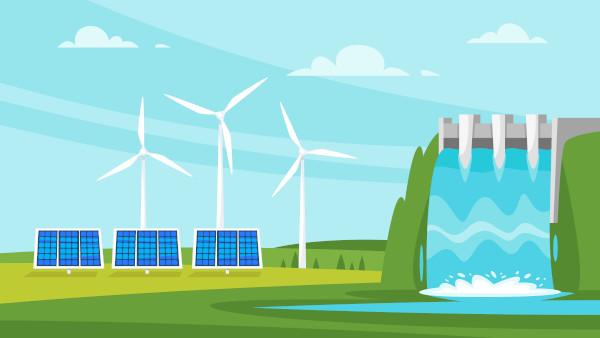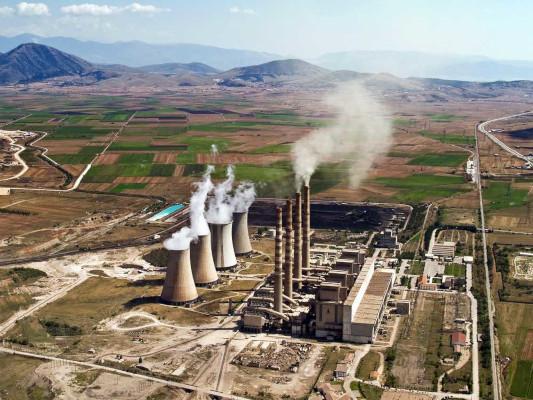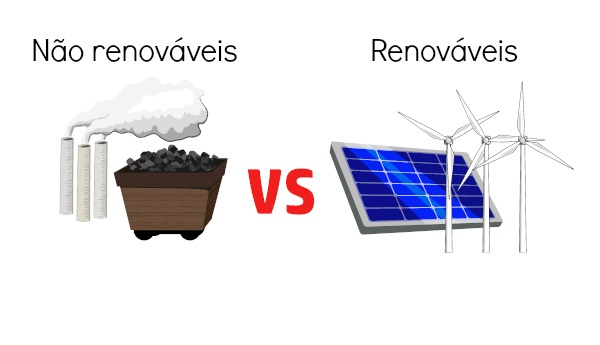At energy sources they are natural or artificial resources used by society to produce some type of energy. Energy, in turn, is used to facilitate the displacement of vehicles, generate heat or produce electricity for various purposes.
Energy sources are also related to environmental issues, as, depending on the ways in which energy resources are used, serious impacts on nature can be caused.
According to the natural capacity to replenish resources, energy sources can be classified into renewableand not renovable.
Renewable Energy Sources
Renewable energy sources, as the name implies, are those that have the capacity to be replaced naturally, which does not mean that all of them are inexhaustible. Some of them, like wind and sunlight, are permanent, but others, like water, can run out, depending on how they are used by humans. It is worth remembering that not every renewable energy source is clean, that is, it is free from the emission of pollutants or large-scale environmental impacts.
→ Wind energy
Wind is a renewable energy resource and, therefore, inexhaustible. In some regions of the planet, its frequency and intensity are sufficient to generate electricity through specific equipment for this function. Basically, the winds activate the turbines of the wind turbines, causing generators convert the mechanical energy produced into electrical energy.
Currently, the wind energy is not so widespread in the world due to the high cost of its equipment. However, some countries, such as the United States, China and Germany, have already substantially adopted this feature. The main advantages of this energy source are the non-emission of pollutants into the atmosphere and low environmental impacts.
Mind Map: Alternative Energy Sources

*To download the mind map in PDF, Click here!
→ Solar energy
THE solar energy it is the use of sunlight to generate electricity and heat water for use. It is also an inexhaustible source of energy, given that the Sun – at least in its current configuration – will exist for billions of years.
There are two ways to harness solar energy: photovoltaic and thermal. In the first form, specific cells are used that employ the “photoelectric effect” to produce electricity. The second way, in turn, uses water heating both for direct use and for steam generation, which will act in the activation processes of energy generators. It is important to remember that other types of liquids can also be used.
Due to the high costs, solar energy is still not widely used. However, its use has been growing gradually, both with the installation of plates in homes, industries and large projects and the construction of solar power plants specifically aimed at generating energy electric.
Read more:Water heating using solar energy
→ Hydroelectric power
THE Hydro-electric energy corresponds to the use of water from rivers to move electricity turbines. In Brazil, this is the main source of electrical energy, alongside thermoelectric plants, given the large potential that the country has in terms of availability of rivers suitable for the generation of hydroelectricity.
In hydroelectric plants, dams are built on the riverbed to impound the water that will be used in the electricity generation process. In this case, the most advisable is that the dams are built in rivers that have uneven levels in their land in order to reduce the flooded surface. Therefore, it is more recommendable to install these plants on plateau rivers, although it is also possible to install them on plain rivers, but with greater environmental impacts.
→ Biomass
The use of biomass it consists of burning substances of organic origin to produce energy. It occurs through the combustion of materials such as firewood, sugarcane bagasse and other agricultural residues, forest residues and even animal excrement. It is considered a renewable energy source, because the carbon dioxide produced during burning is used by the vegetation itself in carrying out photosynthesis. This means that, as long as it is controlled, its use is sustainable as it does not alter the macro-composition of the Earth's atmosphere.
You biofuels, in a way, are considered a type of biomass, as they are also produced from vegetables of organic origin for fuel generation. The best known example is ethanol produced from sugarcane, but there may be other compounds coming from different vegetables, such as castor bean, corn and many others.
→ Tidal energy (tidal wave)
THE tidal energy – or tidal wave – is the use of rising and falling tides to produce electricity. It works relatively similar to an ordinary dam. In addition to the dams, locks and dikes are built that allow the entry and exit of water during floods and low tides, enabling the movement of the turbines.

Renewable energy sources are energy resources that regenerate in the short term.
Non-renewable energy sources
Non-renewable energy sources are those that could be depleted in the relatively near future. Some energy resources, such as oil, are estimated to be exhausted for a few decades, which increases the strategic character of these elements.
→ Fossil fuels
the burning of fossil fuels can be used both for the displacement of vehicles and for the production of electricity in stations thermoelectric. The three main types are Petroleum, mineral coal and natural gas, but there are many others, such as naphtha and oil shale.
Fossil fuels are the most important and disputed energy sources for humanity at the moment. According to the International Energy Agency, around 81.63% of the entire global energy matrix comes from the three main fossil fuels mentioned above. These sources represent 56.8% of the Brazilian energy matrix. Thus, many countries depend on the export of these products, while others take geopolitical measures to obtain them.
Another widely discussed issue regarding fossil fuels refers to the high levels of pollution generated by their burning. Many scholars point out that they are the main responsible for the intensification of the greenhouse effect and for the aggravation of the problems linked to global warming.
→ Nuclear (atomic) energy
At nuclear energy – also called atomic energy –, the production of electricity occurs through the heating of water, which is transformed into steam and activates the generators. In nuclear plants, heat is generated in reactors from the nuclear fission of uranium-235, a highly radioactive material.
Although nuclear power plants are less polluting than other similar stations, such as thermoelectric power plants, they are targeted by many controversies, as the leakage of nuclear waste produced and the occurrence of accidents can generate serious impacts and many deaths. However, with the emergence of the issue of global warming, its use is being reconsidered by many countries.
Each type of energy has its advantages and disadvantages. At the moment, there is no source that is absolutely more viable than the others. Some are cheap and plentiful, but have serious environmental impacts; others are clean and sustainable but financially unfeasible. The most advisable is that there is, in the different territories, a diversity in the energy matrices so that the problems are alleviated. However, this does not happen in Brazil and in most other countries.
Do not stop now... There's more after the advertising ;)
Know more:What are the risks of nuclear power generation?

Non-renewable energy sources, such as fossil fuels, correspond to energy resources that can be depleted in nature.
Advantages and Disadvantages of Using Energy Sources
1. Renewable sources
Power supply |
Advantage |
Disadvantage |
wind energy |
It is considered a clean source as it does not emit polluting gases into the atmosphere. |
The installation of wind turbines causes changes in the landscape and harms the migratory route of birds. |
Solar energy |
It is a clean energy source, abundant in several areas and cost-effective. |
The use of this type of energy still requires technological advances that make its use economically viable. |
Hydro-electric energy |
It is a clean energy source, with low operating cost and short-term renewal. |
It causes environmental damage, impacting biodiversity and the population residing at the plant construction site. |
biomass |
It is a low-polluting energy source whose resources are renewable in the short term. |
Its use can impact water resources due to the demand for water used. It can also cause an increase in deforestation for the allocation of areas for agriculture. |
Tidal energy |
It is considered a clean energy source for minimally harming the environment. |
For its use to be economically viable, it requires technological advances. |
2. Non-renewable sources
Power supply |
Advantage |
Disadvantage |
Fossil fuels |
They have high energy efficiency: burning them releases large amounts of energy. It is easy to locate reservoirs, extract and process. Therefore, they are cheaper than alternative energy sources. |
The intense use of this type of energy source has caused a relevant reduction in reservoirs. Burning these fuels releases polluting gases into the atmosphere, damaging the ozone layer and intensifying global warming. |
Nuclear energy |
The use of this energy source does not release greenhouse gases and does not depend on climatic factors to make its use viable. |
It is expensive energy compared to other energy sources. Its use presents a high potential for risk of nuclear accidents. |

Different energy sources, both renewable and non-renewable, have advantages and disadvantages.
Energy sources in Brazil
About 42% of the production in the Brazilian energy matrix comes from renewable energy sources, such as the use of biomass, ethanol, water resources, solar energy and wind energy. Thus, the Brazilian energy matrix is more renewable than the world matrix, which is mainly based on the use of fossil fuels for energy production. Thus, it can be said that, compared to other countries, Brazil emits less greenhouse gases.
There are, today, in Brazil, 536 wind power plants, in which around 6,600 pinwheels work, a number that places Brazil as a leader in Latin America in this type of energy production. However, the main source of energy in Brazil still comes from hydroelectric plants, which represent approximately 64% of the country's electrical potential. The production of energy from the use of biomass corresponds to about 9.2% of the Brazilian energy matrix, while wind power represents around 8.5% of the matrix.
Read too:The distribution of electricity in Brazil
Exercises on energy sources
1. (Enem) In hydroelectric plants, the waterfall moves turbines that drive generators. In wind farms, generators are powered by propellers driven by the wind. In direct solar-electric conversion, they are photovoltaic cells that produce electrical voltage. In addition to all producing electricity, these processes have in common the fact that:
a) do not cause an environmental impact.
b) independent of weather conditions.
c) the energy generated can be stored.
d) use renewable energy sources.
e) depend on fossil fuel reserves.
→ RESOLUTION:
Alternative D – Hydroelectric energy, wind energy and solar energy are considered renewable energy sources, that is, they are energy resources that can be regenerated in the short term.
2. (Enem) The intention is to install an electric power generation station in a municipality located in the interior of a small valley surrounded by high mountains that are difficult to access. The city is crossed by a river, which is a source of water for consumption, irrigation of subsistence crops and fishing. In the region, which has a small territorial extension, solar incidence is high throughout the year. The station in question will supply only the municipality shown. Which form of obtaining energy, among those presented, is the most suitable to be implemented in this municipality in order to cause the least environmental impact?
a) Thermoelectric, as it is possible to use river water in the refrigeration system.
b) Wind, as the geography of the location is suitable for capturing this type of energy.
c) Nuclear, as the way in which their systems were cooled would not affect the population.
d) Photovoltaic, as it is possible to take advantage of the solar energy that reaches the surface of the site.
e) Hydroelectric power plant, as the river that cuts through the municipality is sufficient to supply the plant built.
→ RESOLUTION:
Alternative D - The region in question has a lot of sunlight throughout the year, so the way to obtain more energy indicated and that causes less impact is solar or photovoltaic energy, which takes advantage of the incidence of sunlight to generate energy.
3. (UDESC) The search for new renewable energy sources emerges as an important alternative to overcome two current problems: a scarcity of non-renewable energy sources, mainly oil, and environmental pollution caused by these sources (fuels fossils).
Check the alternative that presents a type of non-renewable energy resource.
a) Biomass, mass of living beings inhabiting a region.
b) Hydrogen, used as a fuel cell.
c) Biogas, use of bacteria in the transformation of organic waste into methane.
d) Coal, extracted from the earth through the mining process.
e) Geothermal energy, harnessing heat from the Earth's interior.
→ RESOLUTION:
Alternative D – Coal is a type of non-renewable energy resource, that is, it does not regenerate in the short term and can be depleted in nature. Its burning causes emission of polluting gases into the atmosphere, aggravating environmental problems.
By Rafaela Sousa and Me. Rodolfo Alves Pena
Graduated and Master in Geography, respectively.
*Mental Map by Rafaela Sousa
Graduated in Geography
Based on the reading of the following alternatives, mark the one that presents ONLY renewable energy sources:
This type of energy is obtained through the heat generated inside the Earth's crust, being especially installed in areas with intense volcanic activity. What is the name of the renewable energy source discussed in the previous sentence?


